A Night-Time Monitoring System (eNightLog) to Prevent Elderly Wandering in Hostels: A Three-Month Field Study
Abstract
1. Introduction
2. Materials and Methods
2.1. Subject Recruitment and Protocol
2.2. Field Setup
2.3. System Development and Architectures
2.4. Classification Method
2.5. Evaluation Method
3. Results
4. Discussion
Limitations and Application of Study
5. Conclusions
6. Patents
Author Contributions
Funding
Institutional Review Board Statement
Informed Consent Statement
Data Availability Statement
Acknowledgments
Conflicts of Interest
References
- World Health Organization. 10 Facts on Ageing and Health. Available online: https://www.who.int/news-room/fact-sheets/detail/10-facts-on-ageing-and-health (accessed on 5 December 2021).
- Inouye, S.K.; Studenski, S.; Tinetti, M.E.; Kuchel, G.A. Geriatric Syndromes: Clinical, Research, and Policy Implications of a Core Geriatric Concept: (See Editorial Comments by Dr. William Hazzard on pp 794–796). J. Am. Geriatr. Soc. 2007, 55, 780–791. [Google Scholar] [CrossRef] [PubMed]
- Alzheimer’s Disease International. World Alzheimer Report 2015. The Global Impact of Dementia: An Analysis of Prevalence, Incidence, Cost and Trends. Available online: https://www.alz.co.uk/research/WorldAlzheimerReport2015.pdf (accessed on 5 December 2021).
- Alzheimer’s Disease International. World Alzheimer Report 2018. The State of the Art of Dementia research: New Frontiers. Available online: https://www.statista.com/statistics/471323/global-dementia-economic-impact-forecast/ (accessed on 5 December 2021).
- Jorm, A.; Korten, A.; Henderson, A. The prevalence of dementia: A quantitative integration of the literature. Acta Psychiatr. Scand. 1987, 76, 465–479. [Google Scholar] [CrossRef] [PubMed]
- Ebly, E.M.; Parhad, I.M.; Hogan, D.B.; Fung, T. Prevalence and types of dementia in the very old: Results from the Canadian Study of Health and Aging. Neurology 1994, 44, 1593. [Google Scholar] [CrossRef] [PubMed]
- Yu, R.; Chau, P.H.; McGhee, S.M.; Cheung, W.L.; Chan, K.C.; Cheung, S.H.; Woo, J. Trends in prevalence and mortality of dementia in elderly Hong Kong population: Projections, disease burden, and implications for long-term care. Int. J. Alzheimer’s Dis. 2012, 2012, 406852. [Google Scholar] [CrossRef]
- Census and Statistics Department of Hong Kong. Hong Kong Population Projections 2010–2039. Available online: https://www.statistics.gov.hk/pub/B1120015042010XXXXB0100.pdf (accessed on 5 December 2021).
- Barker, W.W.; Luis, C.A.; Kashuba, A.; Luis, M.; Harwood, D.G.; Loewenstein, D.; Waters, C.; Jimison, P.; Shepherd, E.; Sevush, S. Relative frequencies of Alzheimer disease, Lewy body, vascular and frontotemporal dementia, and hippocampal sclerosis in the State of Florida Brain Bank. Alzheimer Dis. Assoc. Disord. 2002, 16, 203–212. [Google Scholar] [CrossRef]
- Petersen, R.C.; Caracciolo, B.; Brayne, C.; Gauthier, S.; Jelic, V.; Fratiglioni, L. Mild cognitive impairment: A concept in evolution. J. Intern. Med. 2014, 275, 214–228. [Google Scholar] [CrossRef]
- Ward, A.; Arrighi, H.M.; Michels, S.; Cedarbaum, J.M. Mild cognitive impairment: Disparity of incidence and prevalence estimates. Alzheimer’s Dement. 2012, 8, 14–21. [Google Scholar] [CrossRef]
- Petersen, R.C.; Doody, R.; Kurz, A.; Mohs, R.C.; Morris, J.C.; Rabins, P.V.; Ritchie, K.; Rossor, M.; Thal, L.; Winblad, B. Current concepts in mild cognitive impairment. Arch. Neurol. 2001, 58, 1985–1992. [Google Scholar] [CrossRef]
- Geda, Y.E. Mild cognitive impairment in older adults. Curr. Psychiatry Rep. 2012, 14, 320–327. [Google Scholar] [CrossRef]
- Holtzman, D.M.; Morris, J.C.; Goate, A.M. Alzheimer’s disease: The challenge of the second century. Sci. Transl. Med. 2011, 3, 77sr1. [Google Scholar] [CrossRef]
- Lanctôt, K.L.; Amatniek, J.; Ancoli-Israel, S.; Arnold, S.E.; Ballard, C.; Cohen-Mansfield, J.; Ismail, Z.; Lyketsos, C.; Miller, D.S.; Musiek, E. Neuropsychiatric signs and symptoms of Alzheimer’s disease: New treatment paradigms. Alzheimer’s Dement. Transl. Res. Clin. Interv. 2017, 3, 440–449. [Google Scholar] [CrossRef] [PubMed]
- Heyat, M.B.; Akhtar, F.; Khan, M.H.; Ullah, N.; Gul, I.; Khan, H.; Lai, D. Detection, Treatment Planning, and Genetic Predisposition of Bruxism: A Systematic Mapping Process and Network Visualization Technique. CNS Neurol. Disord. Drug Targets (Former Curr. Drug Targets—CNS Neurol. Disord.) 2021, 20, 755–775. [Google Scholar] [CrossRef] [PubMed]
- World Health Organization. Dementia Fact Sheet. 2019. Available online: https://www.who.int/en/news-room/fact-sheets/detail/dementia (accessed on 5 December 2021).
- Burns, A.; Iliffe, S. Dementia. BMJ 2009, 338, b75. [Google Scholar] [CrossRef] [PubMed]
- Rolland, Y.; Gillette-Guyonnet, S.; Nourhashémi, F.; Andrieu, S.; Cantet, C.; Payoux, P.; Ousset, P.; Vellas, B. Wandering and Alzheimer’s type disease. Descriptive study. REAL. FR research program on Alzheimer’s disease and management. Rev. De Med. Interne 2003, 24, 333s–338s. [Google Scholar] [CrossRef]
- Utton, D. The design of housing for people with dementia. J. Care Serv. Manag. 2009, 3, 380–390. [Google Scholar] [CrossRef]
- Cipriani, G.; Lucetti, C.; Nuti, A.; Danti, S. Wandering and dementia. Psychogeriatrics 2014, 14, 135–142. [Google Scholar] [CrossRef]
- Teri, L.; Larson, E.B.; Reifler, B.V. Behavioral disturbance in dementia of the Alzheimer’s type. J. Am. Geriatr. Soc. 1988, 36, 1–6. [Google Scholar] [CrossRef]
- Tetewsky, S.J.; Duffy, C.J. Visual loss and getting lost in Alzheimer’s disease. Neurology 1999, 52, 958–965. [Google Scholar] [CrossRef]
- Phillips, V.L.; Diwan, S. The incremental effect of dementia-related problem behaviors on the time to nursing home placement in poor, frail, demented older people. J. Am. Geriatr. Soc. 2003, 51, 188–193. [Google Scholar] [CrossRef]
- Klein, D.A.; Steinberg, M.; Galik, E.; Steele, C.; Sheppard, J.M.; Warren, A.; Rosenblatt, A.; Lyketsos, C.G. Wandering behaviour in community-residing persons with dementia. Int. J. Geriatr. Psychiatry 1999, 14, 272–279. [Google Scholar] [CrossRef]
- Hope, T.; Tilling, K.M.; Gedling, K.; Keene, J.M.; Cooper, S.D.; Fairburn, C.G. The Structure of Wandering in Dementia. Int. J. Geriatr. Psychiatry 1994, 9, 149–155. [Google Scholar] [CrossRef]
- Agrawal, A.K.; Gowda, M.; Achary, U.; Gowda, G.S.; Harbishettar, V. Approach to Management of Wandering in Dementia: Ethical and Legal Issue. Indian J. Psychol. Med. 2021, 43, S53–S59. [Google Scholar] [CrossRef] [PubMed]
- Alzhemier’s Association. Alzhemier’s Disease Facts and Figures. Available online: http://www.alz.org/facts/ (accessed on 5 December 2021).
- Stevenson, D.G.; Studdert, D.M. Trends—The rise of nursing home litigation: Findings from a national survey of attorneys. Health Aff. 2003, 22, 219–229. [Google Scholar] [CrossRef] [PubMed][Green Version]
- Algase, D. Wandering: Clues to effective management. Geriatr. Aging 2005, 8, 55–59. [Google Scholar]
- Colombo, M.; Vitali, S.; Cairati, M.; Perelli-Cippo, R.; Bessi, O.; Gioia, P.; Guaita, A. Wanderers: Features, findings, issues. Arch. Gerontol. Geriatr. Suppl. 2001, 7, 99–106. [Google Scholar] [CrossRef]
- Wick, J.Y.; Zanni, G.R. Aimless excursions: Wandering in the elderly. Consult. Pharm. 2006, 21, 608–612+615–618. [Google Scholar] [CrossRef]
- Yaghoubi, S.; Gooraji, S.A.; Habibi, M.; Torkaman, F. Fall incidence in hospitalized patients and prediction of its risk factors using a weighted Poisson model. J. Public Health 2021. [Google Scholar] [CrossRef]
- Rubenstein, L.Z.; Josephson, K.R. The epidemiology of falls and syncope. Clin. Geriatr. Med. 2002, 18, 141–158. [Google Scholar] [CrossRef]
- Kröpelin, T.F.; Neyens, J.C.; Halfens, R.J.; Kempen, G.I.; Hamers, J.P. Fall determinants in older long-term care residents with dementia: A systematic review. Int. Psychogeriatr. 2013, 25, 549–563. [Google Scholar] [CrossRef]
- Shaw, F.E. Falls in cognitive impairment and dementia. Clin. Geriatr. Med. 2002, 18, 159–173. [Google Scholar] [CrossRef]
- Nelson, A.L. Evidence-Based Protocols for Managing Wandering Behaviors; Springer Publishing Company: Cham, Switzerland, 2007. [Google Scholar]
- Dionyssiotis, Y. Analyzing the problem of falls among older people. Int. J. Gen. Med. 2012, 5, 805–813. [Google Scholar] [CrossRef] [PubMed]
- Feng, Z.; Hirdes, J.P.; Smith, T.F.; Finne-Soveri, H.; Chi, I.; Du Pasquier, J.N.; Gilgen, R.; Ikegami, N.; Mor, V. Use of physical restraints and antipsychotic medications in nursing homes: A cross-national study. Int. J. Geriatr. Psychiatry 2009, 24, 1110–1118. [Google Scholar] [CrossRef] [PubMed]
- Lam, K.; Kwan, J.S.K.; Wai Kwan, C.; Chong, A.M.L.; Lai, C.K.Y.; Lou, V.W.Q.; Leung, A.Y.M.; Liu, J.Y.W.; Bai, X.; Chi, I. Factors Associated with the Trend of Physical and Chemical Restraint Use Among Long-Term Care Facility Residents in Hong Kong: Data From an 11-Year Observational Study. J. Am. Med. Dir. Assoc. 2017, 18, 1043–1048. [Google Scholar] [CrossRef] [PubMed]
- Nakanishi, M.; Okumura, Y.; Ogawa, A. Physical restraint to patients with dementia in acute physical care settings: Effect of the financial incentive to acute care hospitals. Int. Psychogeriatr. 2018, 30, 991–1000. [Google Scholar] [CrossRef] [PubMed]
- Kwok, T.; Bai, X.; Chui, M.Y.P.; Lai, C.K.Y.; Ho, D.W.H.; Ho, F.K.Y.; Woo, J. Effect of Physical Restraint Reduction on Older Patients’ Hospital Length of Stay. J. Am. Med. Dir. Assoc. 2012, 13, 645–650. [Google Scholar] [CrossRef] [PubMed]
- Kwok, T.; Mok, F.; Chien, W.T.; Tam, E. Does access to bed-chair pressure sensors reduce physical restraint use in the rehabilitative care setting? J. Clin. Nurs. 2006, 15, 581–587. [Google Scholar] [CrossRef]
- Yan, E.; Kwok, T.; Lee, D.; Tang, C. The prevalence and correlates of the use of restraint and force on hospitalised older people. J. Nurs. Healthc. Chronic. Illn. 2009, 1, 147–155. [Google Scholar] [CrossRef]
- Choi, E.; Song, M. Physical restraint use in a Korean ICU. J. Clin. Nurs. 2003, 12, 651–659. [Google Scholar] [CrossRef]
- Capezuti, E. Minimizing the use of restrictive devices in dementia patients at risk for falling. Nurs. Clin. N. Am. 2004, 39, 625–647. [Google Scholar] [CrossRef]
- Gallinagh, R.; Nevin, R.; Mc Ilroy, D.; Mitchell, F.; Campbell, L.; Ludwick, R.; McKenna, H. The use of physical restraints as a safety measure in the care of older people in four rehabilitation wards: Findings from an exploratory study. Int. J. Nurs. Stud. 2002, 39, 147–156. [Google Scholar] [CrossRef]
- Hofmann, H.; Hahn, S. Characteristics of nursing home residents and physical restraint: A systematic literature review. J. Clin. Nurs. 2014, 23, 3012–3024. [Google Scholar] [CrossRef] [PubMed]
- Lancaster, G.A.; Whittington, R.; Lane, S.; Riley, D.; Meehan, C. Does the position of restraint of disturbed psychiatric patients have any association with staff and patient injuries? J. Psychiatr. Ment. Health. Nurs. 2008, 15, 306–312. [Google Scholar] [CrossRef] [PubMed]
- Andrews, G.J. Managing challenging behaviour in dementia. BMJ 2006, 332, 741. [Google Scholar] [CrossRef] [PubMed]
- Gastmans, C.; Milisen, K. Use of physical restraint in nursing homes: Clinical-ethical considerations. J. Med. Ethics 2006, 32, 148–152. [Google Scholar] [CrossRef] [PubMed]
- Robinson, L.; Hutchings, D.; Corner, L.; Beyer, F.; Dickinson, H.; Vanoli, A.; Finch, T.; Hughes, J.; Ballard, C.; May, C.; et al. A systematic literature review of the effectiveness of non-pharmacological interventions to prevent wandering in dementia and evaluation of the ethical implications and acceptability of their use. Health Technol. Assess. 2006, 10, iii, ix-108. [Google Scholar] [CrossRef] [PubMed]
- Behrman, S.; Dunn, M. Physical restraint of medical inpatients: Unravelling the red tape. Clin. Ethics 2010, 5, 16–21. [Google Scholar] [CrossRef]
- Dimant, J. Avoiding physical restraints in long-term care facilities. J. Am. Med. Dir. Assoc. 2003, 4, 207–215. [Google Scholar] [CrossRef]
- Ooi, C.H.; Yoon, P.S.; How, C.H.; Poon, N.Y. Managing challenging behaviours in dementia. Singap. Med. J. 2018, 59, 514–518. [Google Scholar] [CrossRef]
- Cheung, J.C.-W.; Tam, E.W.-C.; Mak, A.H.-Y.; Chan, T.T.-C.; Lai, W.P.-Y.; Zheng, Y.-P. Night-time monitoring system (eNightLog) for elderly wandering behavior. Sensors 2021, 21, 704. [Google Scholar] [CrossRef]
- Lai, D.; Heyat, M.B.B.; Khan, F.I.; Zhang, Y. Prognosis of sleep bruxism using power spectral density approach applied on EEG signal of both EMG1-EMG2 and ECG1-ECG2 channels. IEEE Access 2019, 7, 82553–82562. [Google Scholar] [CrossRef]
- Mao, Y.-J.; Lim, H.-J.; Ni, M.; Yan, W.-H.; Wong, D.W.-C.; Cheung, J.C.-W. Breast Tumour Classification Using Ultrasound Elastography with Machine Learning: A Systematic Scoping Review. Cancers 2022, 14, 367. [Google Scholar] [CrossRef] [PubMed]
- Shinmoto Torres, R.L.; Visvanathan, R.; Abbott, D.; Hill, K.D.; Ranasinghe, D.C. A battery-less and wireless wearable sensor system for identifying bed and chair exits in a pilot trial in hospitalized older people. PLoS ONE 2017, 12, e0185670. [Google Scholar] [CrossRef] [PubMed]
- Shorr, R.I.; Chandler, A.M.; Mion, L.C.; Waters, T.M.; Liu, M.; Daniels, M.J.; Kessler, L.A.; Miller, S.T. Effects of an intervention to increase bed alarm use to prevent falls in hospitalized patients: A cluster randomized trial. Ann. Intern. Med. 2012, 157, 692–699. [Google Scholar] [CrossRef] [PubMed]
- Demiris, G.; Hensel, B.K.; Skubic, M.; Rantz, M. Senior residents’ perceived need of and preferences for “smart home” sensor technologies. Int. J. Technol. Assess. Health Care. 2008, 24, 120–124. [Google Scholar] [CrossRef] [PubMed]
- Cho, H.S.; Park, Y.J. Detection of Heart Rate through a Wall Using UWB Impulse Radar. J. Healthc. Eng. 2018, 2018, 4832605. [Google Scholar] [CrossRef]
- Lu, C.; Huang, J.; Lan, Z.; Wang, Q. Bed exiting monitoring system with fall detection for the elderly living alone. In Proceedings of the 2016 International Conference on Advanced Robotics and Mechatronics (ICARM), Macau, China, 18–20 August 2016; pp. 59–64. [Google Scholar]
- Hilbe, J.; Schulc, E.; Linder, B.; Them, C. Development and alarm threshold evaluation of a side rail integrated sensor technology for the prevention of falls. Int. J. Med. Inf. 2010, 79, 173–180. [Google Scholar] [CrossRef]
- Ranasinghe, D.C.; Shinmoto Torres, R.L.; Hill, K.; Visvanathan, R. Low cost and batteryless sensor-enabled radio frequency identification tag based approaches to identify patient bed entry and exit posture transitions. Gait Posture 2014, 39, 118–123. [Google Scholar] [CrossRef]
- Asbjørn, D.; Jim, T. Recognizing Bedside Events Using Thermal and Ultrasonic Readings. Sensors 2017, 17, 1342. [Google Scholar] [CrossRef]
- Ni, B.; Nguyen, C.D.; Moulin, P. RGBD-camera based get-up event detection for hospital fall prevention. In Proceedings of the 2012 IEEE International Conference on Acoustics, Speech and Signal Processing (ICASSP), Kyoto, Japan, 25–30 March 2012; pp. 1405–1408. [Google Scholar]
- Bu, F.; Lin, Q.; Allebach, J. Bed exit detection network (BED Net) for patients bed-exit monitoring based on color camera images. Electron. Imaging 2021, 2021, 269-1–269-8. [Google Scholar] [CrossRef]
- Jones, K.J.; Haynatzki, G.; Sabalka, L. Evaluation of automated video monitoring to decrease the risk of unattended bed exits in small rural hospitals. J. Patient Saf. 2021, 17, e716–e726. [Google Scholar] [CrossRef]
- Capezuti, E.; Brush, B.L.; Lane, S.; Rabinowitz, H.U.; Secic, M. Bed-exit alarm effectiveness. Arch. Geronto.l Geriatr. 2009, 49, 27–31. [Google Scholar] [CrossRef] [PubMed]
- Cheung, C.-W.J.; Chan, W.-H.R.; Chiu, M.-W.; Law, S.-Y.; Lee, T.-H.; Zheng, Y.-P. A three-month study of fall and physical activity levels of intellectual disability using a transfer belt-based motion recording sensor. In Proceedings of the 6th World Congress of Biomechanics (WCB 2010), Singapore, 1–6 August 2010; pp. 1393–1396. [Google Scholar]
- Garn, H.; Kohn, B.; Dittrich, K.; Wiesmeyr, C.; Kloesch, G.; Stepansky, R.; Wimmer, M.; Ipsiroglu, O.; Grossegger, D.; Kemethofer, M.; et al. 3D detection of periodic limb movements in sleep. In Proceedings of the 2016 38th Annual International Conference of the IEEE Engineering in Medicine and Biology Society, Orlando, FL, USA, 16–20 August 2016; pp. 427–430. [Google Scholar] [CrossRef]
- Wong, D.W.-C.; Wang, Y.; Lin, J.; Tan, Q.; Chen, T.L.-W.; Zhang, M. Sleeping mattress determinants and evaluation: A biomechanical review and critique. PeerJ 2019, 7, e6364. [Google Scholar] [CrossRef] [PubMed]
- Tam, A.Y.-C.; So, B.P.-H.; Chan, T.T.-C.; Cheung, A.K.-Y.; Wong, D.W.-C.; Cheung, J.C.-W. A Blanket Accommodative Sleep Posture Classification System Using an Infrared Depth Camera: A Deep Learning Approach with Synthetic Augmentation of Blanket Conditions. Sensors 2021, 21, 5553. [Google Scholar] [CrossRef] [PubMed]
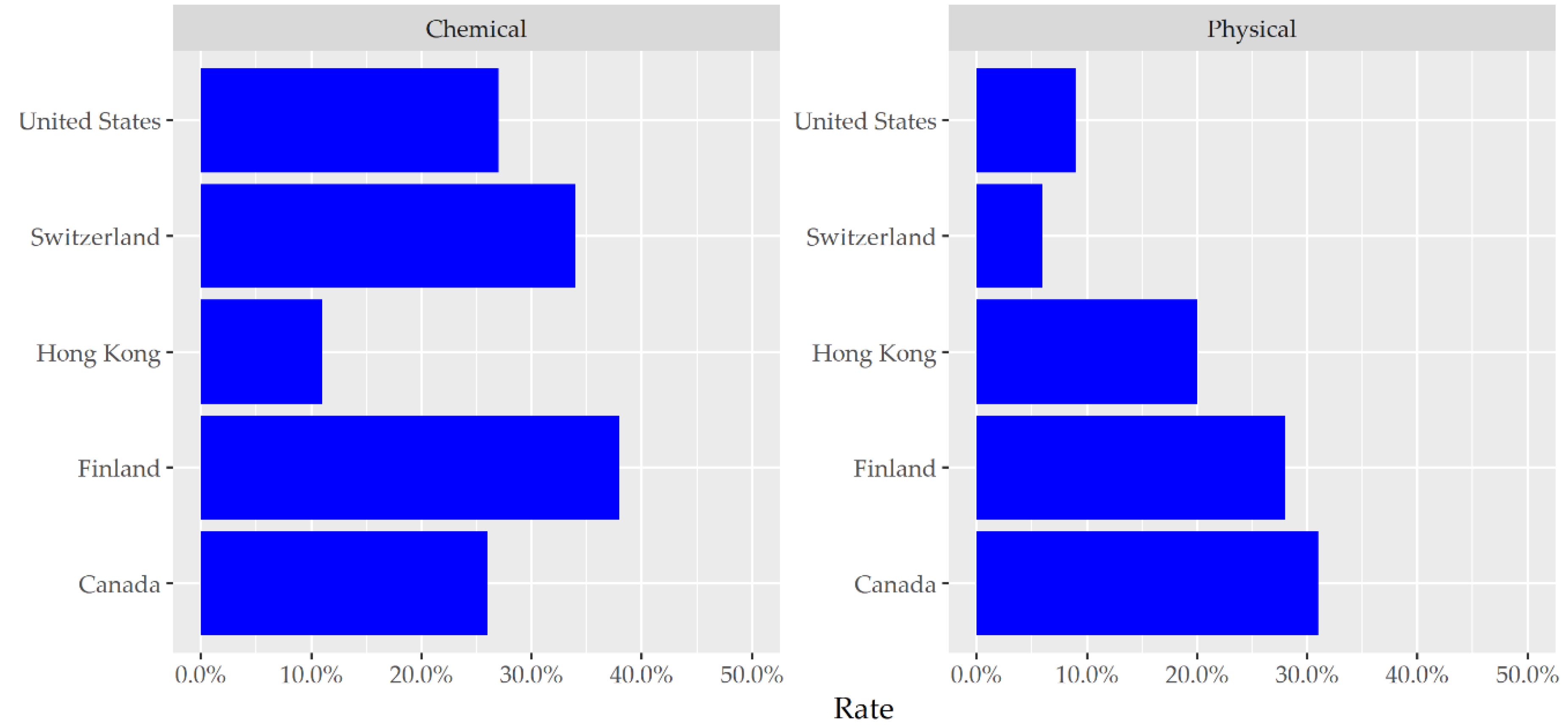

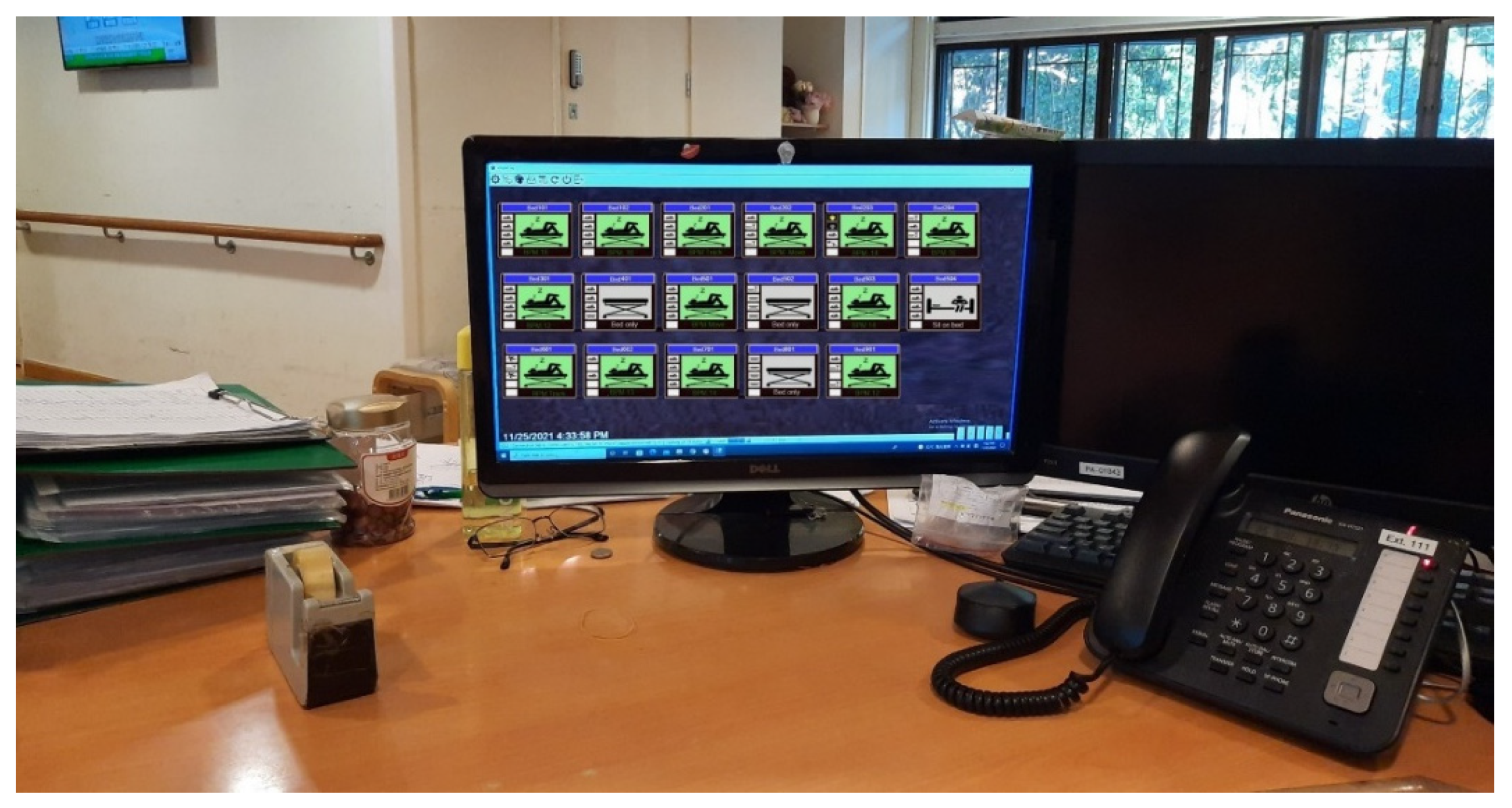
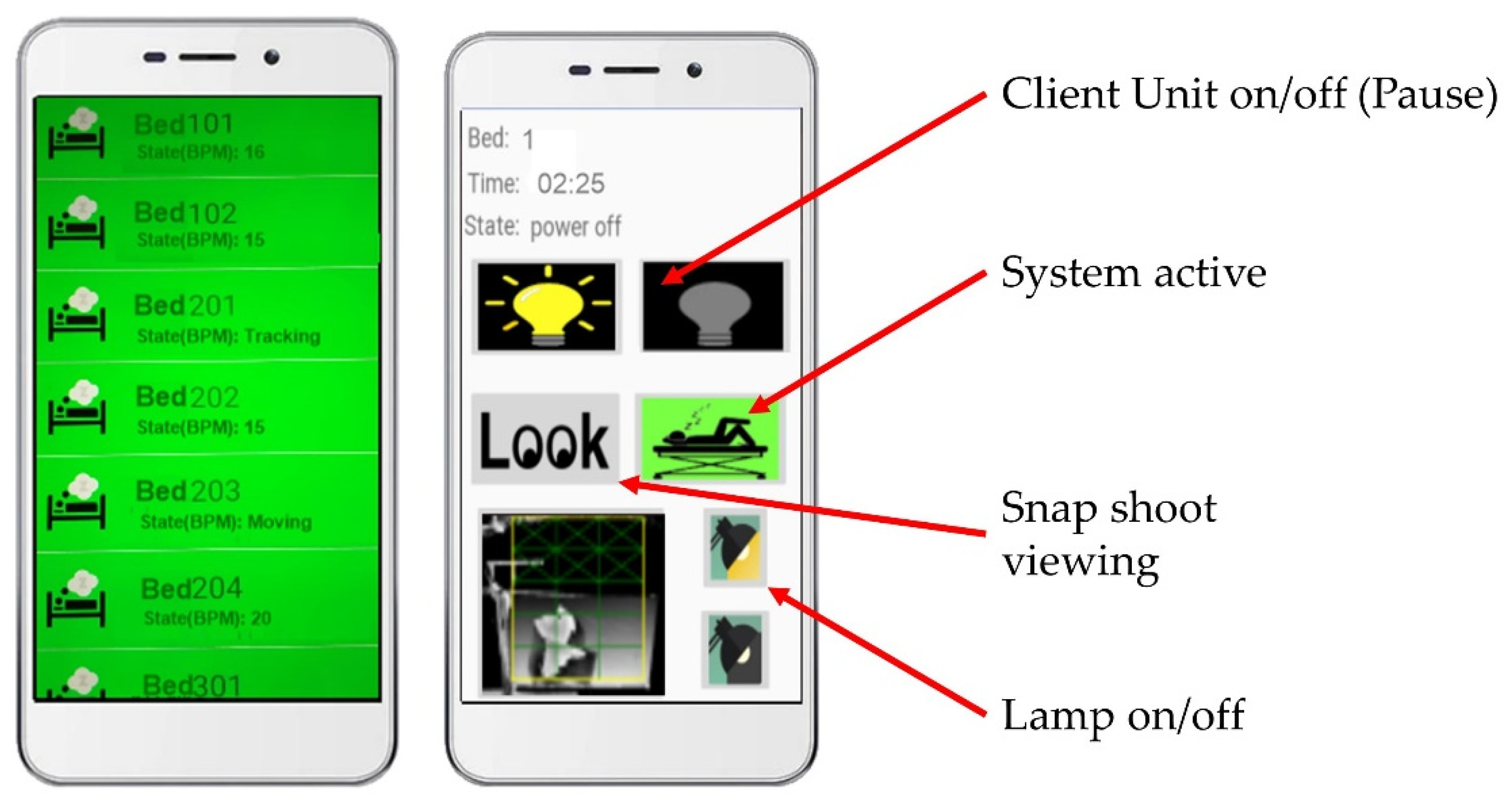
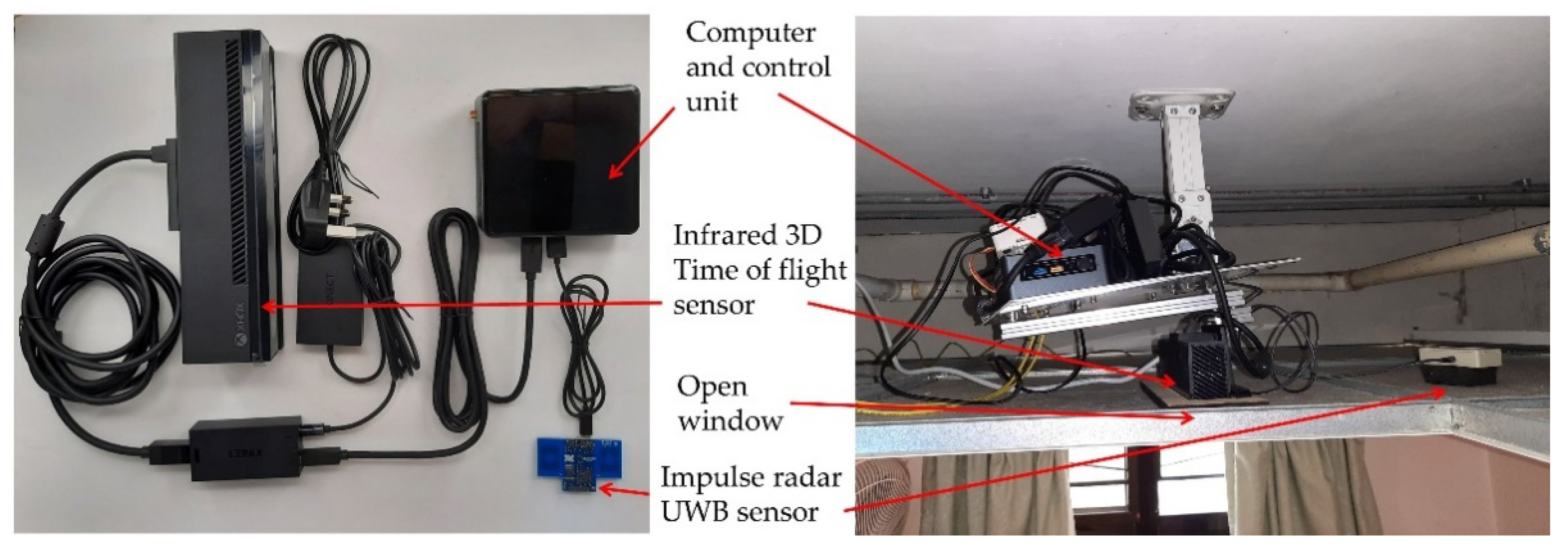
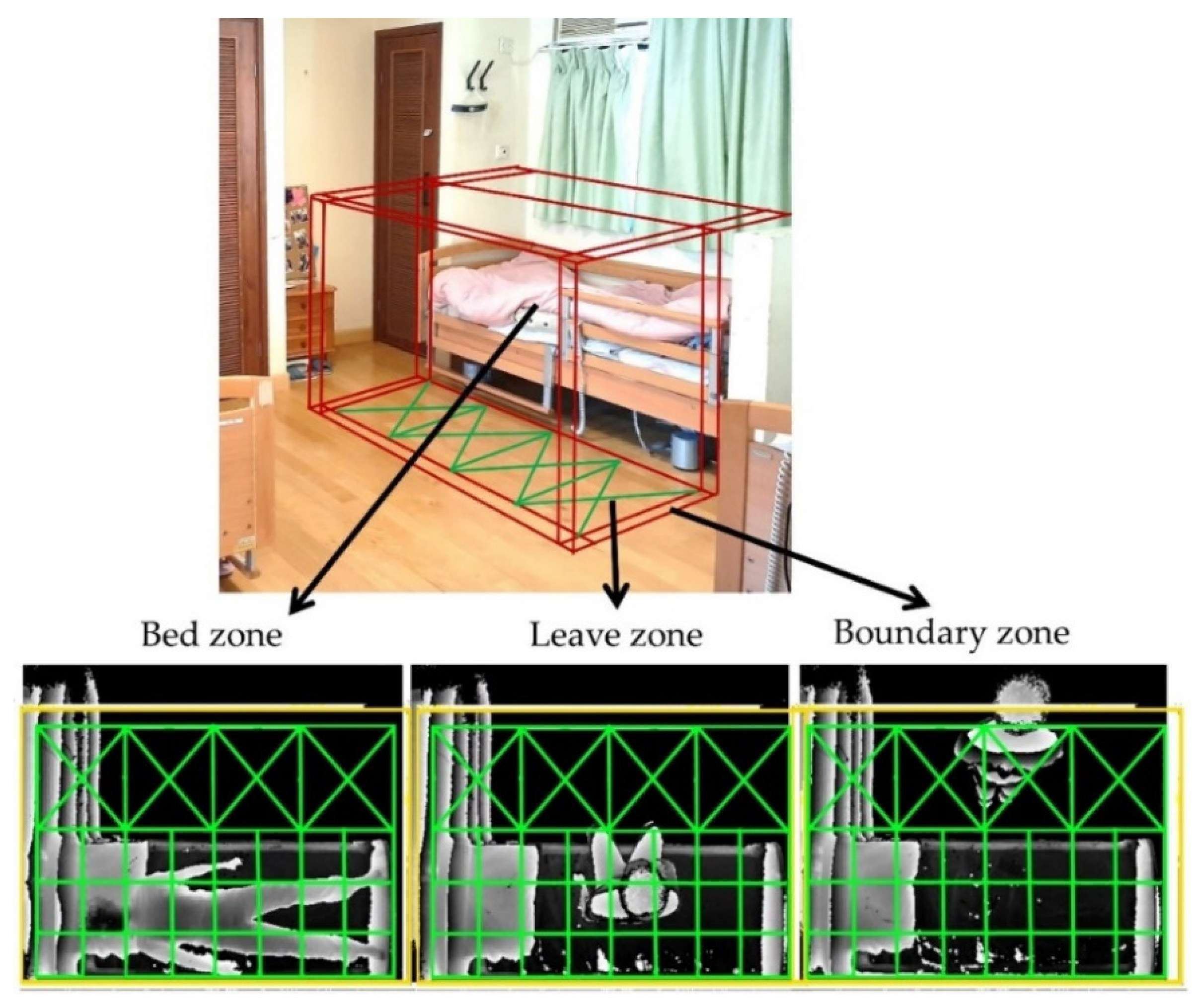
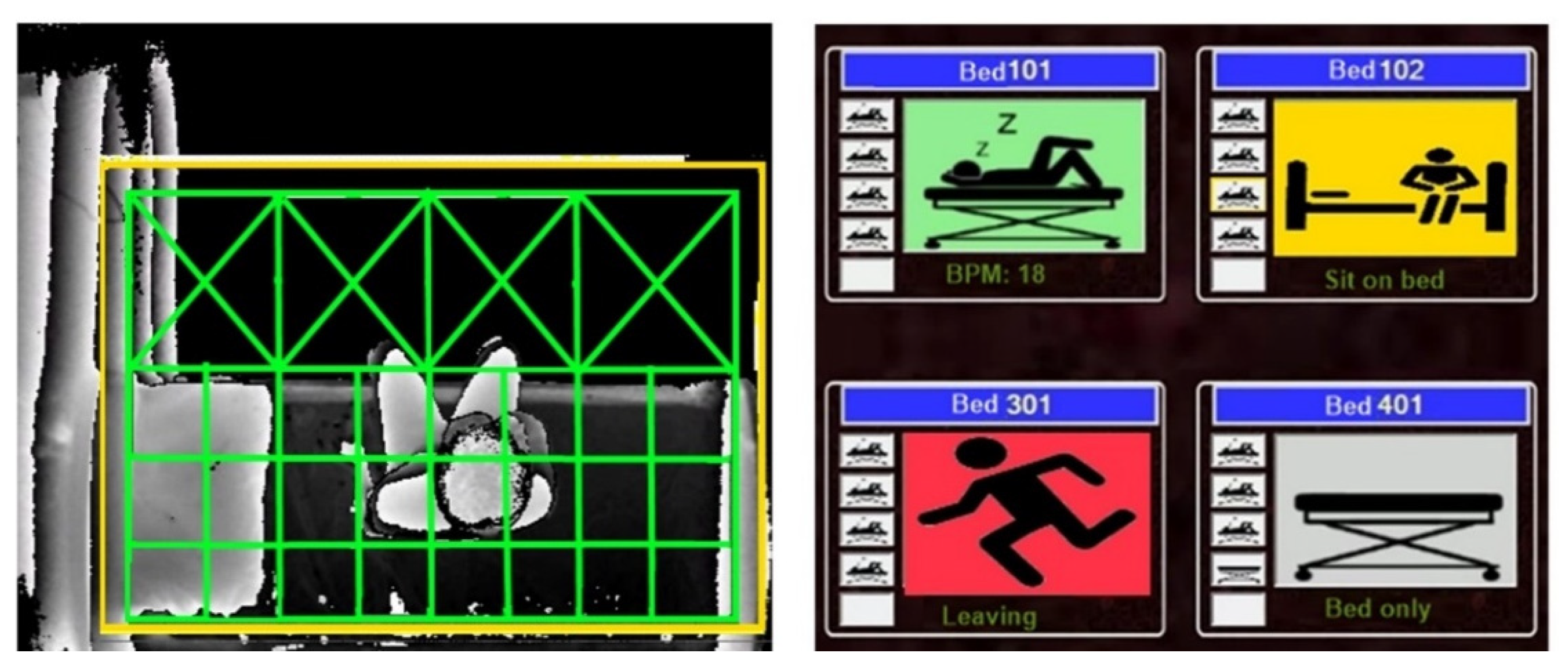

| Setting and Outcome | Non-Assisted Bed Exiting | Assisted Bed Exiting |
|---|---|---|
| Total number of events detected | 1042 | 1720 |
| True Positive (TP) | 521 | 860 |
| True Negative (TN) | 519 | 859 |
| False Positive (FP) | 2 | 1 |
| False Negative (FN) | 0 | 0 |
| Accuracy | 99.8% | 99.9% |
| Precision | 99.6% | 99.9% |
| Sensitivity | 100% | 100% |
| Specificity | 99.6% | 99.9% |
| Study | Our Previous Work [56] | This Study | |||
|---|---|---|---|---|---|
| Setting | Laboratory Test | Field Test | |||
| Single Bed | Single Bed | Double Bed | Multiple Beds & Rooms | ||
| Assisted | No | No | Yes | ||
| System | IFPM | eNightLog | eNightLog | eNightLog | eNightLog |
| No. of bed-exiting events | 1800 | 1800 | 9000 | 1042 | 1720 |
| Accuracy | 85.9% | 99.0% | 98.8% | 99.8% | 99.9% |
| Precision | 78.6% | 99.2% | 97.8% | 99.6% | 99.9% |
| Sensitivity | 98.9% | 98.8% | 99.9% | 100% | 100% |
| Specificity | 73.0% | 99.2% | 97.8% | 99.6% | 99.9% |
| Sensor(s) | Source | Accuracy | Precision | Sensitivity | Specificity |
|---|---|---|---|---|---|
| Infrared fence | [63] | - | - | 85.3% | 96.2% |
| Pressure mat | [63] | - | - | 90.4% | 99.3% |
| Pressure sensor | [64] | - | - | 96% | 95.5% |
| Infrared fence and multiple pressure mats | [63] | - | - | 92.3% | 99.4% |
| RFID | [65] | - | - | 93.8% | 90.8% |
| Thermal array and ultrasonic sensor | [66] | 95.5% | 93.8% | 71.4% | 99.3% |
| Kinect | [67] | 98.8% | - | - | - |
| Colour Camera | [68] | 87.7% | 90.6% | 83.1% | 92.1% |
| Video | [69] | - | 59.4% | 97.4% | - |
| eNightLog (this study) | Assisted | 99.9% | 99.9% | 100% | 99.9% |
| Non-assisted | 99.8% | 99.6% | 100% | 99.6% |
Publisher’s Note: MDPI stays neutral with regard to jurisdictional claims in published maps and institutional affiliations. |
© 2022 by the authors. Licensee MDPI, Basel, Switzerland. This article is an open access article distributed under the terms and conditions of the Creative Commons Attribution (CC BY) license (https://creativecommons.org/licenses/by/4.0/).
Share and Cite
Cheung, J.C.-W.; Tam, E.W.-C.; Mak, A.H.-Y.; Chan, T.T.-C.; Zheng, Y.-P. A Night-Time Monitoring System (eNightLog) to Prevent Elderly Wandering in Hostels: A Three-Month Field Study. Int. J. Environ. Res. Public Health 2022, 19, 2103. https://doi.org/10.3390/ijerph19042103
Cheung JC-W, Tam EW-C, Mak AH-Y, Chan TT-C, Zheng Y-P. A Night-Time Monitoring System (eNightLog) to Prevent Elderly Wandering in Hostels: A Three-Month Field Study. International Journal of Environmental Research and Public Health. 2022; 19(4):2103. https://doi.org/10.3390/ijerph19042103
Chicago/Turabian StyleCheung, James Chung-Wai, Eric Wing-Cheung Tam, Alex Hing-Yin Mak, Tim Tin-Chun Chan, and Yong-Ping Zheng. 2022. "A Night-Time Monitoring System (eNightLog) to Prevent Elderly Wandering in Hostels: A Three-Month Field Study" International Journal of Environmental Research and Public Health 19, no. 4: 2103. https://doi.org/10.3390/ijerph19042103
APA StyleCheung, J. C.-W., Tam, E. W.-C., Mak, A. H.-Y., Chan, T. T.-C., & Zheng, Y.-P. (2022). A Night-Time Monitoring System (eNightLog) to Prevent Elderly Wandering in Hostels: A Three-Month Field Study. International Journal of Environmental Research and Public Health, 19(4), 2103. https://doi.org/10.3390/ijerph19042103







